
Roman Soldiers’ Tattoo History
Home Tattoo Blog Tattoo Gallery Tattoo Buzz Tattoo Books Tattoo Ideas & Designs > Tattoo History > Roman Soldiers’ Tattoo History --> Ancient Tattoo Art: Egyptian Tattoos Dreamcatcher Tattoos Do You Approve of Skinhead Tattoos? UV Tattoo Art: For and Against Medusa Tattoo – the Scaring Gorgon Aries Tattoos Diamond Tattoo Designs Native American Tattoos Teardrop Tattoo Designs Ideas for Upper Back Tattoos Comments Popular Posts Some Facts About Tattoo Military Designs The Cutest 15 Tattoo Images Ever Prank Tattoo Lettering: The Artists Riot Brain-Piercing: Extreme Body Piercing Idea Tribal Lion Tattoo Designs and Meaning Blogroll Award Winning Tattoos Magento Templates PoundedInk Tattoo Me Now Temporary tattoos Recently Written Lip Tattoo Designs Hummingbird Tattoos Sanskrit Tattoos Getting an Eye Tattoo Roman Numeral Tattoos Translate Categories Before You Decide Caribbean Curious Tattoo Facts Extreme Tattoos For Tattoo Artists Piercing Tattoo Care Tattoo Designs Tattoo History Tattoo Meanings Tattoo Removal Uncategorized Archives Info
Europe in the late Bronze Age. Expansion of the Urnfield Culture. The Urnfield culture (c. 1300 BC – 750 BC) was a late Bronze Age culture of central Europe. Chronology[edit] It is believed that in some areas, such as in southwestern Germany, it was in existence around 1200 BC (beginning of Ha A), but the Bronze D Riegsee-phase already contains cremations. The existence of the Ha B3-phase is contested, as the material consists of female burials only. Origin[edit] The origins of the cremation rite are commonly believed to be in Hungary, where it was widespread since the first half of the 2nd millennium BC [3]. Distribution and local groups[edit] The Urnfield culture was located in an area stretching from western Hungary to eastern France, from the Alps to near the North Sea. South-German Urnfield culture Lower-Rhine Urnfield culture Lower Hessian GroupNorth-Netherlands-Westphalian groupNorthwest-Group in the Dutch Delta region Middle-Danube Urnfield culture Gáva culture Related cultures[edit]
Urnfield culture

 Easy to learn 1Indonesian is easy to learn. Within a month of beginning the program, you will find that you are already able to have some simple conversations in Indonesian as well as to write short compositions using the language with no complicating factors or memorisation nightmares. 2Indonesia is a country rich in cultural diversity with hundreds of different ethnic groups. Each group has its own unique traditions and arts, making Indonesia a country of interest to students of anthropology, ethnomusicology, theater, and art. DIVERSE in Religion 3 Indonesia has the largest Moslem population of any country in the world. Developing Nation 4 Indonesia is a developing nation rich in natural and human resources and promising economic potential, making it a country of interest to economists, geographers, international businessmen and women, and development workers.
Easy to learn 1Indonesian is easy to learn. Within a month of beginning the program, you will find that you are already able to have some simple conversations in Indonesian as well as to write short compositions using the language with no complicating factors or memorisation nightmares. 2Indonesia is a country rich in cultural diversity with hundreds of different ethnic groups. Each group has its own unique traditions and arts, making Indonesia a country of interest to students of anthropology, ethnomusicology, theater, and art. DIVERSE in Religion 3 Indonesia has the largest Moslem population of any country in the world. Developing Nation 4 Indonesia is a developing nation rich in natural and human resources and promising economic potential, making it a country of interest to economists, geographers, international businessmen and women, and development workers.
The Indonesian Language - Bahasa Indonesia
Human
Humans began to practice sedentary agriculture about 12,000 years ago, domesticating plants and animals which allowed for the growth of civilization. Humans subsequently established various forms of government, religion, and culture around the world, unifying people within a region and leading to the development of states and empires. The rapid advancement of scientific and medical understanding in the 19th and 20th centuries led to the development of fuel-driven technologies and improved health, causing the human population to rise exponentially. By 2012 the global human population was estimated to be around 7 billion.[10][11] Etymology and definition In common usage, the word "human" generally refers to the only extant species of the genus Homo — anatomically and behaviorally modern Homo sapiens. In scientific terms, the definition of "human" has changed with the discovery and study of the fossil ancestors of modern humans. History Evolution and range Evidence from molecular biology
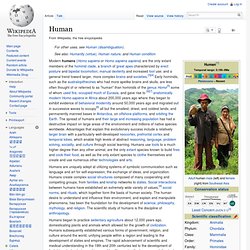
IB History of the Americas
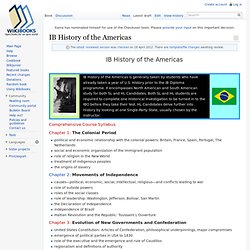 IB History of the Americas Comprehensive Course Syllabus Chapter 1: The Colonial Period political and economic relationship with the colonial powers: Britain, France, Spain, Portugal, The Netherlandssocial and economic organization of the immigrant populationrole of religion in the New Worldtreatment of indigenous peoplesthe origins of slavery Chapter 2: Movements of Independence causes—political, economic, social, intellectual, religious—and conflicts leading to warrole of outside powersroles of the social classesrole of leadership: Washington, Jefferson, Bolívar, San Martínthe Declaration of Independenceindependence of BrazilHaitian Revolution and the Republic: Toussaint L’Ouverture Chapter 3: Evolution of New Governments and Confederation Chapter 4: Slavery in the Americas conditions of enslavement: adaptation and resistancethe pro-slavery argumentsinsurrections and reactionslife of the free African–Americanspro-abolition arguments Chapter 10: The Mexican Revolution, 1910 to 1940 US History
IB History of the Americas Comprehensive Course Syllabus Chapter 1: The Colonial Period political and economic relationship with the colonial powers: Britain, France, Spain, Portugal, The Netherlandssocial and economic organization of the immigrant populationrole of religion in the New Worldtreatment of indigenous peoplesthe origins of slavery Chapter 2: Movements of Independence causes—political, economic, social, intellectual, religious—and conflicts leading to warrole of outside powersroles of the social classesrole of leadership: Washington, Jefferson, Bolívar, San Martínthe Declaration of Independenceindependence of BrazilHaitian Revolution and the Republic: Toussaint L’Ouverture Chapter 3: Evolution of New Governments and Confederation Chapter 4: Slavery in the Americas conditions of enslavement: adaptation and resistancethe pro-slavery argumentsinsurrections and reactionslife of the free African–Americanspro-abolition arguments Chapter 10: The Mexican Revolution, 1910 to 1940 US History
IB European History
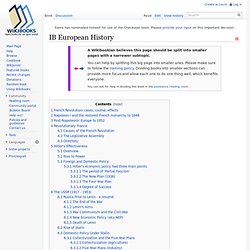 French Revolution: cases, course, effects[edit] intellectual origins, philosophiesLouis XVI and the monarchy, ancien régimepolitical, fiscal, economic problemsconstitutional experiments, radicals, terrorRobespierre, Jacobins, Girondinsrevolutionary wars, reaction, the Directory, rise of Napoleon I Napoleon I and the restored French monarchy to 1848[edit] Napoleon I: domestic and foreign policiesNapoleonic wars, the Treaties of Paris, the Vienna Settlementrestored Bourbons: Louis XVIII, 1814 to 1824; Charles X, 1824 to 1830; Louis Philippe,1830 to 1848revolutions in France, 1830 and 1848 Post-Napoleonic Europe to 1852[edit] Vienna and post-Napoleonic settlement, attitudes of the Great Powerslater Congresses: Aix-la-Chapelle, Troppau, Laibach and VeronaMetternich’s influence in Austria–Hungary and Europedemands for parliamentary/constitutional reform1848 revolutions: causes, events, suppression, results Revolutionary France[edit] National Constituent Assembly Abolished feudalism 1789 1. 2. 3. 4.
French Revolution: cases, course, effects[edit] intellectual origins, philosophiesLouis XVI and the monarchy, ancien régimepolitical, fiscal, economic problemsconstitutional experiments, radicals, terrorRobespierre, Jacobins, Girondinsrevolutionary wars, reaction, the Directory, rise of Napoleon I Napoleon I and the restored French monarchy to 1848[edit] Napoleon I: domestic and foreign policiesNapoleonic wars, the Treaties of Paris, the Vienna Settlementrestored Bourbons: Louis XVIII, 1814 to 1824; Charles X, 1824 to 1830; Louis Philippe,1830 to 1848revolutions in France, 1830 and 1848 Post-Napoleonic Europe to 1852[edit] Vienna and post-Napoleonic settlement, attitudes of the Great Powerslater Congresses: Aix-la-Chapelle, Troppau, Laibach and VeronaMetternich’s influence in Austria–Hungary and Europedemands for parliamentary/constitutional reform1848 revolutions: causes, events, suppression, results Revolutionary France[edit] National Constituent Assembly Abolished feudalism 1789 1. 2. 3. 4.
IB History Revision Notes - History
The duel: Are empires always bad?
Yes—Elleke Boehmer Is killing other people bad? Yes. Is rapacious invasion bad? Absolutely. There are few or no neutral parties in empires. Everyone in the modern world is a product of empire in some way; we are shaped by the wars it propagated and migrations that followed, and the drawing and changing of borders that it introduced. No—Tom Holland Empires create their own reality. Do this effectively, and it is possible, over the centuries—or indeed millennia—for the boundary between victors and vanquished to blur, and then to vanish altogether. “Across history,” you write, “empires have involved the imposition of force by one power or people upon others.” Are these scenes “good” or “bad”? To condemn this as “bad” seems, at a distance of 5,000 years, not a little arrogant—or in cultural terms, verging on the imperial. Yes The gist of your response is that empires are a fact of history and we should accept their collateral damage. No You have mentioned Fanon. Hence the paradox.
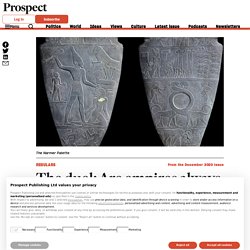
History
Egypt, land of the pyramids, mighty monuments constructed in the early days of history. Monuments that endure to this day attracting visitors across the world. Many visitors come to Egypt to see one pyramid in particular, the Great Pyramid of Cheops at Giza, one of the Seven Wonders of the World, the most celebrated man-made constructions of all time. Of the seven, only the Great Pyramid of Cheops survives, but history and archaeology are able to tell us the stories of all seven, including the Hanging Gardens of Babylon, the Statue of Zeus at Olympia, the Temple of Artemis at Ephesus, the Mausoleum at Halicarnassus, the Colossus of Rhodes, and the Pharos of Alexandria. And for the first time in some 3,000 years, viewers see the Seven Wonders restored to their original glory. Twit This!

History and WWW History: Sources on the Net
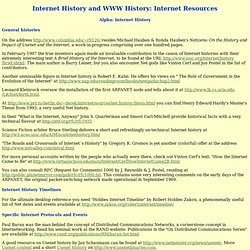 Alpha: Internet History General histories On the address resides Michael Hauben & Ronda Hauben's Netizens: On the History and Impact of Usenet and the Internet, a work-in-progress comprising over one hundred pages. In February 1997 the true inventors again made an invaluable contribution to the canon of Internet histories with their extremely interesting text A Brief History of the Internet, to be found at the URL Another unmissable figure in Internet history is Robert E. Leonard Kleinrock oversaw the installation of the first ARPANET node and tells about it at At you can find Henry Edward Hardy's Master's Thesis from 1993, a very useful Net history. In their "What is the Internet, Anyway" John S. "The Roads and Crossroads of Internet´s History" by Gregory R. Internet History Timelines
Alpha: Internet History General histories On the address resides Michael Hauben & Ronda Hauben's Netizens: On the History and Impact of Usenet and the Internet, a work-in-progress comprising over one hundred pages. In February 1997 the true inventors again made an invaluable contribution to the canon of Internet histories with their extremely interesting text A Brief History of the Internet, to be found at the URL Another unmissable figure in Internet history is Robert E. Leonard Kleinrock oversaw the installation of the first ARPANET node and tells about it at At you can find Henry Edward Hardy's Master's Thesis from 1993, a very useful Net history. In their "What is the Internet, Anyway" John S. "The Roads and Crossroads of Internet´s History" by Gregory R. Internet History Timelines
Put the power of primary sources to work in the classroom. Browse ready-to-use lesson plans, student activities, collection guides and research aids. The Library of Congress National Archives National Endowment for the Humanities National Gallery of Art Browse online materials (PDFs, interactive lesson plans, and podcasts) and borrow free-loan resources (teaching packets, DVDs/VHS) on art by female artists at NGA Learning Resources. For Kids Louise Bourgeois, Spider, “Lizzy & Gordon Visit the Sculpture Garden” Louise Bourgeois created this giant spider sculpture to represent her mother (who died when she was 21). Inside Scoop Elisabeth Vigée-LeBrun (PDF, 147Kb) Vigée-LeBrun was one of late-eighteenth-century France’s most successful portrait painters—often she had a waiting list! Video National Park Service Download the Adobe Acrobat Reader to view PDF documents.

For Teachers - Women's History Month (Library of Congress)
History Curriculum Homeschool | Heritage History
PGCE History at UEA - Drama and Role-play - Welcome
Drama is often seen by student teachers as one of the riskiest classroom strategies. Unless well-managed, drama can quickly become noisy, chaotic and difficult to control. And yet, ask pupils at the end of the school year what they enjoyed most or (more significantly) what history they best remembered, and the chances are that your risk-taking role-play is top of the list. For me empathy is the most important historical skill. The following examples include the full secondary age-range and all abilities. Examples: 1. 2. 3. 4. 5. 6. Examples with video from Richard Jones-Nerzic
New Zealand Electronic Text Collection
findNZarticles | Collections
Site providers findNZarticles began as a collaboration between Christchurch City Libraries, Dunedin Public Libraries, Landcare Research NZ Ltd and the National Library of New Zealand. Participation is open to any interested institutions. See what's in findNZarticles or contact us for more information. Bibliography of New Zealand Bibliographies – compiled by Tony Millett, hosted by University of Waikato Browse the Bibliography of New Zealand Bibliographies This bibliography lists bibliographies published in New Zealand or about New Zealand since 1960. Bibliography of Published New Zealand Family Histories – compiled by Tony Millett, hosted by University of Waikato Browse the Bibliography of Published New Zealand Family Histories A listing of separately published histories of families with descendants in New Zealand. Bibliography of the Greater Waikato Region – University of Waikato Browse the Bibliography of the Greater Waikato Region Browse the Bibliography on Homosexuality in New Zealand
History Learning Site
The Artistic History of American Anti-Asian Racism - Steven Heller
A new book traces the source of the stereotypical, harmful image of "the Orient." The frontise piece from "Some Reasons for Chinese Exclusion" (Washington D.C.: American Federation of Labor, 1902). Fales Library and Special Collections, NYU (Public domain) More than a century before Coca Cola’s controversial Super Bowl commercial celebrating America as a nation of nations, the melting pot overflowed with people of all races and ethnicities—each subject to its share of mass media abuse. Immigration made America what it is, but not without considerable racist barbing and comic hazing by cartoonists, illustrators, and artists. Blacks, Indians, Irish, Jews, and Asians were the main targets. With China’s reemergence today, the term “Yellow Peril” is still faintly whispered. Caricature, the meat of stereotype, works best when loosely rooted in distortions of truth; exaggerated appearance, for instance, serves to reinforce negative impressions while building misconceptions.
History
Those who cannot remember the past are condemned to repeat it.[1] History (from Greek ἱστορία, historia, meaning "inquiry, knowledge acquired by investigation")[2] is the study of the past, particularly how it relates to humans.[3][4] It is an umbrella term that relates to past events as well as the memory, discovery, collection, organization, presentation, and interpretation of information about these events. Scholars who write about history are called historians. Events occurring prior to written record are considered prehistory. History can also refer to the academic discipline which uses a narrative to examine and analyse a sequence of past events, and objectively determine the patterns of cause and effect that determine them.[5][6] Historians sometimes debate the nature of history and its usefulness by discussing the study of the discipline as an end in itself and as a way of providing "perspective" on the problems of the present.[5][7][8][9] Etymology Description Historiography
Recorded history
Recorded history or written history is a historical narrative based on a written record or other documented communication. Recorded history can be contrasted with other narratives of the past such as mythological or oral traditions. For world history, recorded history begins with the accounts of the ancient world around the 4th millennium BC, and coincides with the invention of writing. For some regions of the world, written history is limited to a relatively recent period in human history. The interpretation of recorded history often relies on historical method, or the set of techniques and guidelines by which historians use primary sources and other evidence to research and then to write accounts of the past. Prehistory[edit] Sumerian inscription in monumental archaic style, c. 26th century BCE Protohistory refers to the transition period between prehistory and history, after the advent of literacy in a society but before the writings of the first historians. Historical accounts[edit]
History
Historian
Medieval Demographics
World Culture
Myths About the Middle Ages


 Roman Soldiers’ Tattoo History
Home Tattoo Blog Tattoo Gallery Tattoo Buzz Tattoo Books Tattoo Ideas & Designs > Tattoo History > Roman Soldiers’ Tattoo History --> Ancient Tattoo Art: Egyptian Tattoos Dreamcatcher Tattoos Do You Approve of Skinhead Tattoos? UV Tattoo Art: For and Against Medusa Tattoo – the Scaring Gorgon Aries Tattoos Diamond Tattoo Designs Native American Tattoos Teardrop Tattoo Designs Ideas for Upper Back Tattoos Comments Popular Posts Some Facts About Tattoo Military Designs The Cutest 15 Tattoo Images Ever Prank Tattoo Lettering: The Artists Riot Brain-Piercing: Extreme Body Piercing Idea Tribal Lion Tattoo Designs and Meaning Blogroll Award Winning Tattoos Magento Templates PoundedInk Tattoo Me Now Temporary tattoos Recently Written Lip Tattoo Designs Hummingbird Tattoos Sanskrit Tattoos Getting an Eye Tattoo Roman Numeral Tattoos Translate Categories Before You Decide Caribbean Curious Tattoo Facts Extreme Tattoos For Tattoo Artists Piercing Tattoo Care Tattoo Designs Tattoo History Tattoo Meanings Tattoo Removal Uncategorized Archives Info
Roman Soldiers’ Tattoo History
Home Tattoo Blog Tattoo Gallery Tattoo Buzz Tattoo Books Tattoo Ideas & Designs > Tattoo History > Roman Soldiers’ Tattoo History --> Ancient Tattoo Art: Egyptian Tattoos Dreamcatcher Tattoos Do You Approve of Skinhead Tattoos? UV Tattoo Art: For and Against Medusa Tattoo – the Scaring Gorgon Aries Tattoos Diamond Tattoo Designs Native American Tattoos Teardrop Tattoo Designs Ideas for Upper Back Tattoos Comments Popular Posts Some Facts About Tattoo Military Designs The Cutest 15 Tattoo Images Ever Prank Tattoo Lettering: The Artists Riot Brain-Piercing: Extreme Body Piercing Idea Tribal Lion Tattoo Designs and Meaning Blogroll Award Winning Tattoos Magento Templates PoundedInk Tattoo Me Now Temporary tattoos Recently Written Lip Tattoo Designs Hummingbird Tattoos Sanskrit Tattoos Getting an Eye Tattoo Roman Numeral Tattoos Translate Categories Before You Decide Caribbean Curious Tattoo Facts Extreme Tattoos For Tattoo Artists Piercing Tattoo Care Tattoo Designs Tattoo History Tattoo Meanings Tattoo Removal Uncategorized Archives Info

 Easy to learn 1Indonesian is easy to learn. Within a month of beginning the program, you will find that you are already able to have some simple conversations in Indonesian as well as to write short compositions using the language with no complicating factors or memorisation nightmares. 2Indonesia is a country rich in cultural diversity with hundreds of different ethnic groups. Each group has its own unique traditions and arts, making Indonesia a country of interest to students of anthropology, ethnomusicology, theater, and art. DIVERSE in Religion 3 Indonesia has the largest Moslem population of any country in the world. Developing Nation 4 Indonesia is a developing nation rich in natural and human resources and promising economic potential, making it a country of interest to economists, geographers, international businessmen and women, and development workers.
The Indonesian Language - Bahasa Indonesia
Easy to learn 1Indonesian is easy to learn. Within a month of beginning the program, you will find that you are already able to have some simple conversations in Indonesian as well as to write short compositions using the language with no complicating factors or memorisation nightmares. 2Indonesia is a country rich in cultural diversity with hundreds of different ethnic groups. Each group has its own unique traditions and arts, making Indonesia a country of interest to students of anthropology, ethnomusicology, theater, and art. DIVERSE in Religion 3 Indonesia has the largest Moslem population of any country in the world. Developing Nation 4 Indonesia is a developing nation rich in natural and human resources and promising economic potential, making it a country of interest to economists, geographers, international businessmen and women, and development workers.
The Indonesian Language - Bahasa Indonesia

 IB History of the Americas Comprehensive Course Syllabus Chapter 1: The Colonial Period political and economic relationship with the colonial powers: Britain, France, Spain, Portugal, The Netherlandssocial and economic organization of the immigrant populationrole of religion in the New Worldtreatment of indigenous peoplesthe origins of slavery Chapter 2: Movements of Independence causes—political, economic, social, intellectual, religious—and conflicts leading to warrole of outside powersroles of the social classesrole of leadership: Washington, Jefferson, Bolívar, San Martínthe Declaration of Independenceindependence of BrazilHaitian Revolution and the Republic: Toussaint L’Ouverture Chapter 3: Evolution of New Governments and Confederation Chapter 4: Slavery in the Americas conditions of enslavement: adaptation and resistancethe pro-slavery argumentsinsurrections and reactionslife of the free African–Americanspro-abolition arguments Chapter 10: The Mexican Revolution, 1910 to 1940 US History
IB History of the Americas Comprehensive Course Syllabus Chapter 1: The Colonial Period political and economic relationship with the colonial powers: Britain, France, Spain, Portugal, The Netherlandssocial and economic organization of the immigrant populationrole of religion in the New Worldtreatment of indigenous peoplesthe origins of slavery Chapter 2: Movements of Independence causes—political, economic, social, intellectual, religious—and conflicts leading to warrole of outside powersroles of the social classesrole of leadership: Washington, Jefferson, Bolívar, San Martínthe Declaration of Independenceindependence of BrazilHaitian Revolution and the Republic: Toussaint L’Ouverture Chapter 3: Evolution of New Governments and Confederation Chapter 4: Slavery in the Americas conditions of enslavement: adaptation and resistancethe pro-slavery argumentsinsurrections and reactionslife of the free African–Americanspro-abolition arguments Chapter 10: The Mexican Revolution, 1910 to 1940 US History
 French Revolution: cases, course, effects[edit] intellectual origins, philosophiesLouis XVI and the monarchy, ancien régimepolitical, fiscal, economic problemsconstitutional experiments, radicals, terrorRobespierre, Jacobins, Girondinsrevolutionary wars, reaction, the Directory, rise of Napoleon I Napoleon I and the restored French monarchy to 1848[edit] Napoleon I: domestic and foreign policiesNapoleonic wars, the Treaties of Paris, the Vienna Settlementrestored Bourbons: Louis XVIII, 1814 to 1824; Charles X, 1824 to 1830; Louis Philippe,1830 to 1848revolutions in France, 1830 and 1848 Post-Napoleonic Europe to 1852[edit] Vienna and post-Napoleonic settlement, attitudes of the Great Powerslater Congresses: Aix-la-Chapelle, Troppau, Laibach and VeronaMetternich’s influence in Austria–Hungary and Europedemands for parliamentary/constitutional reform1848 revolutions: causes, events, suppression, results Revolutionary France[edit] National Constituent Assembly Abolished feudalism 1789 1. 2. 3. 4.
French Revolution: cases, course, effects[edit] intellectual origins, philosophiesLouis XVI and the monarchy, ancien régimepolitical, fiscal, economic problemsconstitutional experiments, radicals, terrorRobespierre, Jacobins, Girondinsrevolutionary wars, reaction, the Directory, rise of Napoleon I Napoleon I and the restored French monarchy to 1848[edit] Napoleon I: domestic and foreign policiesNapoleonic wars, the Treaties of Paris, the Vienna Settlementrestored Bourbons: Louis XVIII, 1814 to 1824; Charles X, 1824 to 1830; Louis Philippe,1830 to 1848revolutions in France, 1830 and 1848 Post-Napoleonic Europe to 1852[edit] Vienna and post-Napoleonic settlement, attitudes of the Great Powerslater Congresses: Aix-la-Chapelle, Troppau, Laibach and VeronaMetternich’s influence in Austria–Hungary and Europedemands for parliamentary/constitutional reform1848 revolutions: causes, events, suppression, results Revolutionary France[edit] National Constituent Assembly Abolished feudalism 1789 1. 2. 3. 4.


 Alpha: Internet History General histories On the address resides Michael Hauben & Ronda Hauben's Netizens: On the History and Impact of Usenet and the Internet, a work-in-progress comprising over one hundred pages. In February 1997 the true inventors again made an invaluable contribution to the canon of Internet histories with their extremely interesting text A Brief History of the Internet, to be found at the URL Another unmissable figure in Internet history is Robert E. Leonard Kleinrock oversaw the installation of the first ARPANET node and tells about it at At you can find Henry Edward Hardy's Master's Thesis from 1993, a very useful Net history. In their "What is the Internet, Anyway" John S. "The Roads and Crossroads of Internet´s History" by Gregory R. Internet History Timelines
Alpha: Internet History General histories On the address resides Michael Hauben & Ronda Hauben's Netizens: On the History and Impact of Usenet and the Internet, a work-in-progress comprising over one hundred pages. In February 1997 the true inventors again made an invaluable contribution to the canon of Internet histories with their extremely interesting text A Brief History of the Internet, to be found at the URL Another unmissable figure in Internet history is Robert E. Leonard Kleinrock oversaw the installation of the first ARPANET node and tells about it at At you can find Henry Edward Hardy's Master's Thesis from 1993, a very useful Net history. In their "What is the Internet, Anyway" John S. "The Roads and Crossroads of Internet´s History" by Gregory R. Internet History Timelines
 For Teachers - Women's History Month (Library of Congress)
For Teachers - Women's History Month (Library of Congress)